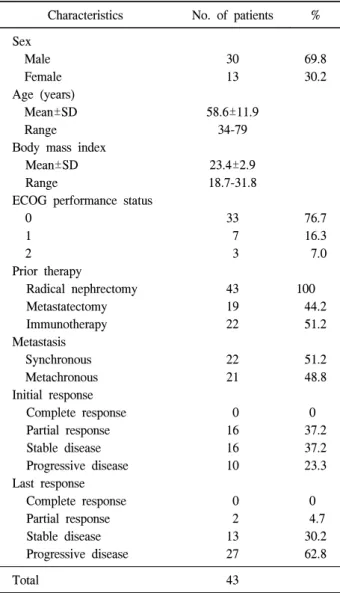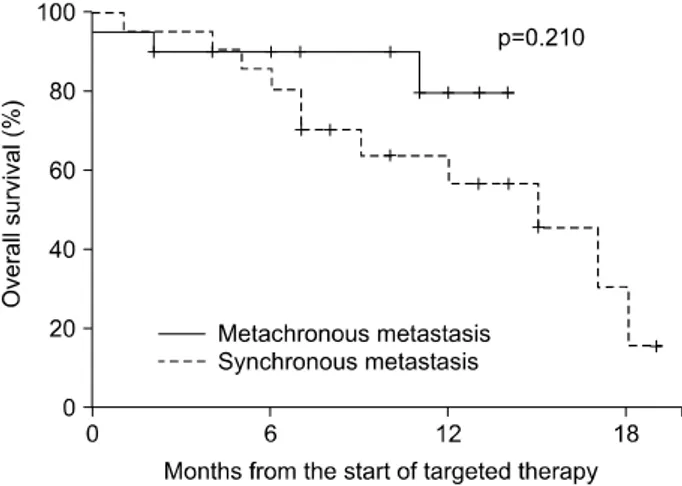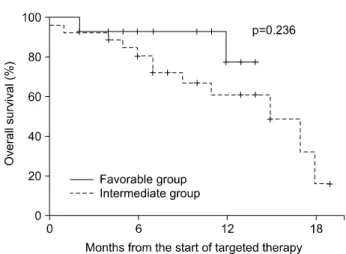1
Targeted Therapy in Metastatic Renal Cell Carcinoma
Yong Hyun Park, Min Yong Kang, In Sik Hwang, Chan Soo Park, Sung Han Kim, Ja Hyun Ku, Cheol Kwak, Hyeon Hoe Kim
From the Department of Urology, Seoul National University College of Medicine, Seoul, Korea
Purpose: To evaluate the efficacy and safety of targeted therapy in patients with metastatic renal cell carcinoma.
Materials and Methods: In this retrospective analysis, 43 consecutive patients with metastatic renal cell carcinoma received targeted therapy between December 2005 and December 2007. All patients underwent radical nep- hrectomy. Twenty-two patients received targeted therapy as a first-line treatment and 21 as a second-line treatment.
Results: The median follow-up duration after radical nephrectomy and after the initiation of targeted therapy was 87 and 14 months, respectively.
The initial response rate was 74.4% (partial response 37.2%, stable disease 37.2%) and the last response rate was 34.9% (partial response 4.7%, stable disease 30.2%). The median survival was 17 months (95% confidence interval (CI), 11.6-22.4) and the median progression-free survival was 10 months (95% CI, 7.5-12.5). Eleven patients (50%) with synchronous metastasis and 3 (14.3%) with metachronous metastasis died from renal cell carcinoma (p=0.023), but there was no significant difference in terms of median survival (15 months vs. longer than 14 months, p=0.210). Also, there was a significant difference in the overall mortality of the MSKCC risk groups (13.3% vs. 44.4%, p=0.049), but no significant difference in median survival (longer than 14 months vs. 15 months, p=0.236).
Conclusions: Targeted therapy shows promising clinical activity in patients with metastatic renal cell carcinoma. Time to metastasis and MSKCC risk group may be associated with overall survival, and the prognostic implications of those factors should be analyzed in further prospective studies. (Korean J Urol 2009;50:1-5)
Key Words: Renal cell carcinoma, Angiogenesis inhibitors, Prognosis
대한비뇨기과학회지 제 50 권 제 1 호 2009
서울대학교 의과대학 비뇨기과학교실
박용현ㆍ강민용ㆍ황인식 박찬수ㆍ김성한ㆍ구자현 곽 철ㆍ김현회
접수일자:2008년 8월 25일 채택일자:2008년 10월 21일
교신저자: 김현회
서울대학교병원 비뇨기과 서울시 종로구 연건동 28
110-744
TEL: 02-2072-2425 FAX: 02-742-4665 E-mail: hhkim@snu.ac.kr
서 론
신세포암은 비뇨기계 암 중에서는 세 번째로 흔한 암으 로, 2007년 미국에서 51,190명의 환자가 신세포암으로 진단 을 받았으며 12,890명의 환자가 신세포암으로 사망한 것으 로 추정된다.1 신세포암은 진단 당시에 이미 약 30%의 환자 가 원격전이를 동반하게 되며 국소성 신세포암의 경우에도 약 20-50%의 환자가 추적 관찰 기간 중 재발하게 된다. 전 이성 신세포암은 항암치료 및 방사선치료에 잘 반응하지 않는 대표적인 암으로, 그 동안 면역치료가 주로 시행되어
왔으나 반응률이 10-15%로 낮고 평균 생존 기간이 겨우 1 년 정도로 치료 효과가 그다지 좋지 않아서,2 새로운 효과적 인 약제의 개발이 절실히 필요한 질환으로 인식되어 왔다.
최근 신세포암의 발생 기전에 대한 활발한 연구 결과, Von Hippel-Lindau (VHL) 유전자가 비활성화되면서 종양의 신생혈관생성을 유발한다는 사실이 밝혀지면서 이를 억제 하기 위한 표적치료제가 개발되어 관심의 대상이 되고 있 다.3 이 중 sorafenib, sunitinib, temsirolimus는 이미 신세포암 의 치료에 대하여 미국 Food and Drug Administration (FDA) 의 공인을 받은 약제로, 국내에서도 점점 그 사용 빈도가 증가하고 있다. 그러나 아직 국내에서 표적치료제의 치료
Table 1. Patient characteristics and best response
Characteristics No. of patients % Sex
Male 30 69.8
Female 13 30.2
Age (years)
Mean±SD 58.6±11.9
Range 34-79
Body mass index
Mean±SD 23.4±2.9
Range 18.7-31.8
ECOG performance status
0 33 76.7
1 7 16.3
2 3 7.0
Prior therapy
Radical nephrectomy 43 100
Metastatectomy 19 44.2
Immunotherapy 22 51.2
Metastasis
Synchronous 22 51.2
Metachronous 21 48.8
Initial response
Complete response 0 0
Partial response 16 37.2
Stable disease 16 37.2
Progressive disease 10 23.3
Last response
Complete response 0 0
Partial response 2 4.7
Stable disease 13 30.2
Progressive disease 27 62.8
Total 43
ECOG: Eastern Cooperative Oncology Group 효과나 부작용, 생존율 등과 관련한 연구 발표는 전무한 실
정이다. 이에 저자들은 본원에서 전이성 신세포암 환자를 대상으로 시행하였던 표적치료의 성적을 분석하여 보고하 고자 한다.
대상 및 방법
1. 대상
2005년 12월부터 2007년 12월까지 본원 비뇨기과에서 신 세포암으로 근치적 신적출술을 시행 받은 환자 중 원격전 이가 발견되어 표적치료를 시행 받은 47례 중 중도 탈락한 4례를 제외한 43례를 대상으로 하였다. 남자가 30명, 여자 가 13명이었으며, 평균 연령은 58.6±11.9세였다. 대상 환자 들의 의무기록 및 병리학적 검사 결과, 방사선학적 검사 결 과 등을 후향적으로 분석하였으며, 생존 여부를 전화 인터 뷰를 통하여 확인하였다.
2. 치료 방법 및 치료 반응의 평가
Sorafenib은 400mg을 1일 2회 매일 복용하는 방식으로 4 주 주기로 투약하였으며, sunitinib은 50mg을 4주간 매일 복 용하고 2주간 휴약하는 방식으로 6주 주기로 투약하였다.
부작용이 발생할 경우 sorafenib은 400mg을 1일 1회로 감량 하거나 일시 중단하였으며, sunitinib은 37.5mg, 25mg, 12.5mg 으로 감량하거나 일시 중단하였다.
Sorafenib은 4주마다, sunitinib은 6주마다 환자의 병변 위 치에 따라 흉부 단순 X-선 검사, 복부 및 흉부 전산화단층촬 영, 동위원소 골주사 사진 등을 선택하여 시행하였다. 치료 반응의 판정은 Response Evaluation Criteria in Solid Tumors (RECIST)의 기준에 따라,4 치료의 독성 평가는 NCI common toxicity criteria, version 2에 따라 시행하였다.
3. 통계 분석
통계 분석은 SPSS 11.0 for Windows를 사용하였고, 각 군 에 대한 항목비교는 Mann-Whitney U test와 Pearson’s chi- square test를 이용하였으며, 각 군 간 생존율의 차이는 Ka- plan-Meier analysis를 시행한 후 log-rank test를 사용하여 검 정하였다. 유의수준은 p값이 0.05 미만인 경우 통계적으로 유의하다고 판정하였다.
결 과
1. 환자군의 분석
술 후 중앙 추적기간은 87개월이었으며, 표적치료 후 중 앙 추적기간은 14개월이었다.
3명의 환자를 제외하고는 모두 Eastern Cooperative Oncol- ogy Group (ECOG) performance status 1 이상이었으며 (Table 1), MSKCC risk group5에 따라 분류 하였을 때 favorable-risk group이 15례 (34.9%), intermediate-risk group이 28례 (65.1%) 였으며 poor-risk group은 없었다. 조직학적 유형에 따라 분 류하였을 때, clear cell type이 38례 (88.4%), chromophobe type, papillary type, collecting duct type이 각각 1례 (2.3%)였 으며, unclassified type이 2례 (4.7%)였다.
진단 당시 이미 원격전이가 있었던 환자는 22명 (51.2%), 추적 기간 중 원격전이가 발견된 환자는 21명 (48.8%)이었 으며, 술 후 원격전이가 발견되기까지의 기간은 평균 25.7 (±19.7)개월이었다. 표적치료를 일차치료로 시행한 경우가 22명 (51.2%), 이차치료로 시행한 경우가 21명 (48.8%)이었 다. 치료 약제로는 11례 (25.6%)에서 sorafenib을 사용하였으
Fig. 2. Survival time in 43 patients with metastatic renal cell carcinoma treated with targeted therapy; 28 patients were alive at the end of follow-up.
Fig. 3. Survival stratified according to the first-line or second-line treatment.
Fig. 4. Survival stratified according to the time from initial diagnosis to metastasis.
Fig. 1. Progression-free survival in 43 patients with metastatic renal cell carcinoma treated with targeted therapy; 14 patients were progression-free at the end of follow-up.
며, 32례 (74.4%)에서 sunitinib을 사용하였다.
2. 부작용
Sunitinib의 경우 9례 (28.1%)에서 grade 3 이상의 혈소판 감소증이 발생하였으며, 6례 (18.8%)에서 grade 3 이상의 호 중구감소증이 발생하였다. 그 밖에 grade 3의 갑상선기능저 하증이 3례 (9.4%), 수족증후군 (hand-foot syndrome)이 5례 (15.6%), 점막염이 4례 (12.5%)에서 발생하였다. 14례 (43.8%) 에서 부작용으로 인한 용량의 감량이 필요하였으며, 용량 감량 후 부작용의 정도가 호전되어 치료를 계속 시행할 수 있었다. Sorafenib의 경우 grade 3 이상의 부작용은 발생하지 않았다.
3. 치료 반응
표적치료에 대한 초기 반응률은 74.4% (부분 관해 37.2%, 안정 병변 37.2%)였으나, 최종 반응률은 34.9% (부분 관해 4.7%, 안정 병변 30.2%)였다 (Table 1). 초기에 부분 관해 및 안정 병변으로 치료에 반응을 보였다가 진행하기까지 걸리 는 시간은 10개월 (95% CI, 7.5-12.5)이었다 (Fig. 1).
추적 기간 중 사망한 환자는 모두 14명 (32.6%)으로, 중앙 생존기간은 17개월 (95% CI, 11.6-22.4)이었다 (Fig. 2). 표적 치료를 일차치료로 시행한 경우와 이차치료로 시행한 경우 중앙 생존기간은 14개월 이상과 17개월 (95% CI, 13.2-20.8) 로 통계적으로 유의한 차이는 없었다 (p=0.211) (Fig. 3). 진 단 당시 이미 전이가 발견된 22명 중 11명 (50%)과 추적 기 간 중 전이가 발견된 21명 중 3명 (14.3%)이 사망하였으나 (p=0.023), 중앙 생존기간은 15개월 (95% CI, 11.6-22.4)과
Fig. 5. Survival stratified according to risk group.
14개월 이상으로 통계적으로 의미 있는 차이는 없었다 (p=
0.210) (Fig. 4). Favorable-risk group에서 2명 (13.3%)과 inter- mediate-risk group에서 12명 (44.4%)이 사망하였으나 (p=0.049), 중앙 생존값은 14개월 이상과 15개월 (95% CI, 11.6-22.4)로 통계적으로 의미 있는 차이는 없었다 (p=0.236) (Fig. 5).
고 찰
전이성 신세포암은 항암치료나 방사선치료에 반응하지 않는 대표적인 암으로, 표적치료제가 개발되기 전까지는 면역치료가 주로 시행되어 왔다. 그러나 interleukin-2 (IL-2) 와 interferon-alpha (IFN-α)를 근간으로 하는 면역 치료의 경 우에도 치료 반응률이나 생존 기간 등에는 한계가 있었다.2 이에 최근 다양한 기전을 가지는 표적치료제가 개발되었으 며, 이 중에서도 vascular endothelial growth factor (VEGF) receptor와 platelet-derived growth factor (PDGF) receptor를 표 적으로 하는 sunitinib과 sorafenib은 기존의 면역치료와 비교 하여 탁월한 효과를 보이면서 최근에는 전이성 신세포암 치료의 표준 치료로 고려되고 있다.
Sunitinib은 VEGFR, PDGFR, KIT, FLT3R tyrosine kinase 등을 억제하여 종양의 신생혈관생성을 억제함으로써 항암 효과를 가진다.6 최근 발표된 대규모 연구에서 sunitinib은 34-40%의 치료에 대한 반응을 보이고 있어 기존의 면역요 법에 비하여 훨씬 우월한 결과를 보이고 있다.7,8 또한 상당 수의 환자들이 안정 병변을 보이고 있어 실제로 표적치료 로 인한 임상적 효과를 거둔 환자는 63-67%에 이르는 것으 로 보고되고 있다. Sorafenib은 VEGFR, PDGFR, raf kinase 등을 억제하는 경구 표적치료제로 sunitinib과 마찬가지로 종양의 신생혈관생성을 억제하는 효과를 가진다. Sorafenib 의 치료 반응률은 10% 정도로 sunitinib에 비하여 낮게 보고
되고 있으나, 74%의 안정 병변을 유지함으로써 전반 생존 율의 증가를 기대할 수 있다.9 저자들의 연구에서도 표적치 료는 기존의 보고에서처럼 면역치료나 항암치료보다 월등 히 높은 치료 반응률을 보여서 초기에는 부분 관해 37.2%의 치료 반응률과 안정 병변 37.2%의 임상적 효과를 보였다.
그러나 상당수의 환자가 장기간의 투약 후에는 표적치료제 에 불응하여 질병이 진행하였다. 현재까지 표적치료제에 불응하는 상태로 이행하는 것과 관련해서 이를 설명할 만 한 정확한 기전은 알려져 있지 않다. 그러나 이는 전이성 신세포암의 일차 치료로 대두되고 있는 표적치료의 한계를 보여주는 결과로서, 일차치료에 실패한 경우 효과적인 이 차치료제 및 다른 약제와의 병합 요법에 대한 연구가 시급 함을 보여주는 결과라고 할 수 있다.
대부분의 연구에서 sunitinib으로 인하여 발생하는 부작용 은 대부분 피로, 설사, 구역, 소화불량, 수족증후군, 점막염, 호중구감소증, 혈소판감소증 등으로 보고하고 있으며, 이는 저자들의 연구와 종류나 빈도 면에서 크게 다르지 않았 다.6,8 부작용은 대부분 일시적으로 약물의 용량을 줄이거나 휴약 기간을 가지면 해결되었으며, 이로 인하여 중도 탈락 한 경우는 10% 미만이었다. 물론 sunitinib의 용량을 줄여 사용할 경우 치료 반응이나 생존 기간 등에 영향이 있지는 않은지, 용량을 어느 정도까지, 얼마나 줄여서 사용할 경우 치료 반응에 지장 없이 치료를 시행할 수 있을지에 대해서 는 아직 보고된 바가 없어 추가적인 연구가 필요하다.
전이성 신세포암에 대한 표적치료의 예후에 영향을 미치 는 인자에 대해서는 외국에서도 아직 보고된 바가 많지는 않다. Choueiri 등10은 신세포암 진단에서 표적치료까지의 기간이 2년 이내인 경우, 치료 전 혈소판 및 중성 백혈구 수치가 각각 300K/μl와 4.5K/μl 이상인 경우, 치료 전 칼슘 수치가 8.5mg/dl 이하이거나 10mg/dl 이상인 경우, ECOG 신 체수행능력지수가 높은 경우가 표적 치료의 예후에 부정적 인 영향을 미치는 독립적인 예후인자라고 보고하였다. 본 연구에서도 위의 결과와 유사하게 진단 당시 이미 원격전 이가 있었던 경우와 MSKCC risk group에서 intermediate-risk group인 경우에 신세포암으로 인한 사망이 더 많이 발생하 였다. 그러나 이에 대한 생존 분석을 시행하였을 때에는 통 계적으로 의미 있는 차이는 확인되지 않았다. 이는 본 연구 의 대상 환자수가 적고, 아직 추적 기간이 14개월 정도로 길지 않기 때문인 것으로 생각한다.
저자들의 연구에서 눈여겨보아야 할 부분 중 하나는 통 계적으로 유의하지는 않았으나 표적치료를 이차치료로 시 행한 경우가 일차치료로 시행한 경우에 비하여 중앙 생존 기간이 길었다는 점이다. De Mulder11는 면역치료에 실패한 이후 표적치료를 시행할 경우 오히려 좀 더 효과적인 결과
를 보인다고 하면서, 아직 이를 뒷받침할 만한 과학적인 근 거는 없으나 면역치료를 시행할 때 이미 환자군의 선택이 이루어지면서 좀 더 좋은 예후를 가지는 환자들이 이차치 료군에 들어가기 때문일 것이라고 가정하였다. 만약 실제 로 표적치료를 면역치료를 시행한 후 진행한 군에서 시행 하는 것이 보다 효과적이라면 이는 현재의 치료의 지침을 변경시킬 수도 있는 중요한 문제일 것이다.
결 론
표적치료 시행 후 초기 반응률은 74.4%, 중앙 생존기간은 17개월로 기존에 보고된 다른 치료 방법에 비하여 훨씬 우 월한 치료 성적을 거둘 수 있었다. 본 연구 결과 진단 후 전이까지의 기간이 긴 환자나 MSKCC risk group에서 fa- vorable-risk group에 속하는 환자가 표적치료에 대한 반응이 좋을 것으로 기대되나 이와 관련해서는 향후 더 많은 연구 가 필요할 것이다.
REFERENCES
1. Jemal A, Siegel R, Ward E, Murray T, Xu J, Thun MJ. Cancer statistics, 2007. CA Cancer J Clin 2007;57:43-66
2. McDermott DF. Update on the application of interleukin-2 in the treatment of renal cell carcinoma. Clin Cancer Res 2007;
13:716s-20
3. Pantuck AJ, Zeng G, Belldegrun AS, Figlin RA. Pathobiology, prognosis, and targeted therapy for renal cell carcinoma: ex- ploiting the hypoxia-induced pathway. Clin Cancer Res 2003;
9:4641-52
4. Therasse P, Arbuck SG, Eisenhauer EA, Wanders J, Kaplan RS, Rubinstein L, et al. New guidelines to evaluate the response to treatment in solid tumors. European Organization for Research and Treatment of Cancer, National Cancer Institute of the United States, National Cancer Institute of Canada. J Natl Cancer Inst 2000;92:205-16
5. Motzer RJ, Bacik J, Murphy BA, Russo P, Mazumdar M.
Interferon-alfa as a comparative treatment for clinical trials of new therapies against advanced renal cell carcinoma. J Clin Oncol 2002;20:289-96
6. Motzer RJ, Michaelson MD, Redman BG, Hudes GR, Wilding G, Figlin RA, et al. Activity of SU11248, a multitargeted inhibitor of vascular endothelial growth factor receptor and platelet-derived growth factor receptor, in patients with meta- static renal cell carcinoma. J Clin Oncol 2006;24:16-24 7. Motzer RJ, Rini BI, Bukowski RM, Curti BD, George DJ,
Hudes GR, et al. Sunitinib in patients with metastatic renal cell carcinoma. JAMA 2006;295:2516-24
8. Motzer RJ, Hutson TE, Tomczak P, Michalson MD, Bukowski RM, Rixe O, et al. Sunitinib versus interferon alfa in metastatic renal-cell carcinoma. N Engl J Med 2007;356:115-24 9. Escudier B, Eisen T, Stadler WM, Szczylik C, Oudard S,
Siebels M, et al. Sorafenib in advanced clear-cell renal-cell carcinoma. N Engl J Med 2007;356:125-34
10. Choueiri TK, Garcia JA, Elson P, Khasawneh M, Usman S, Golshayan AR, et al. Clinical factors associated with outcome in patients with metastatic clear-cell renal cell carcinoma treated with vascular endothelial growth factor-targeted therapy. Cancer 2007;110:543-50
11. De Mulder PH. Targeted therapy in metastatic renal cell carcinoma. Ann Oncol 2007;18(Suppl 9):98-102


